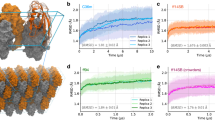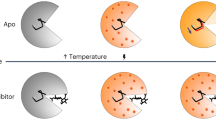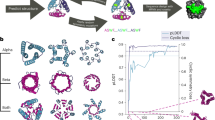Abstract
We have investigated the magnitude and timescale of fluctuations within the core of a protein using the exchange kinetics of indole and benzene binding to engineered hydrophobic cavities in T4 lysozyme. The crystal structures of variant–benzene complexes suggest that relatively large scale fluctuations (1–2 Å) of backbone atoms are required for entry of these ligands into the core. Nonetheless, these ligands enter the cavities rapidly, with bimolecular rate constants of ∼106–107 M−1 s−1 and a low activation barrier, 2–5 kcal mol−1. These results suggest that protein cores undergo substantial fluctuations on the millisecond to microsecond timescale and that entry of small molecules into protein interiors is not strongly limited by steric occlusion.
This is a preview of subscription content, access via your institution
Access options
Subscribe to this journal
Receive 12 print issues and online access
$259.00 per year
only $21.58 per issue
Buy this article
- Purchase on SpringerLink
- Instant access to full article PDF
Prices may be subject to local taxes which are calculated during checkout
Similar content being viewed by others
References
Miller, R.J.D. Energetics and dynamics of deterministic protein motion. Accts. Chem. Res. 27, 145–150 (1994).
Karplus, M. & McCammon, J.A. The dynamics of proteins. Sci. Amer. April issue 4, 42–51 (1986).
Debrunner, P.G. & Frauenfelder, H. Dynamics of proteins. A. Rev. Phys. Chem. 33, 283–299 (1982).
Gurd, F.R.N. & Rothgeb, T.M. Motions in proteins. Adv. Prot.Chem. 33, 73–165 (1979).
Karplus, M. & McCammon, J.A. Dynamics of proteins: elements and function. A. Rev. Biochem. 52, 263–300 (1983).
Case, D.A. & Wright, P.E. Determination of high-resolution NMR structures of proteins, in NMR of Proteins (eds G. M. Clore & A.M. Gronenborn) 53–91 (MacMillian, London; 1993).
Smith, J.C. Protein dynamics: comparison of simulation with elastic neutron scattering experiments. Q. Rev, Biophys. 24, 227–291 (1991).
McCammon, J.A., Lee, C.Y. & Northrup, S.H. Side-chain rotational isomerization in proteins: a mechanism involving gating and transient packing defects. J. Am. Chem. Soc. 105, 2232–2237 (1983).
Kneller, G.R. & Smith, J.C. Liquid-like side-chain dynamics in myoglobin. J. Mol. Bio. 242, 181–185 (1994).
Wagner, G. NMR relaxation and protein mobility. Curr. Op. Struct. Biol. 3, 748–754 (1993).
Palmer, III A. G., Dynamic properties of proteins from NMR spectroscopy. Curr. Op. Biotech. 4, 385–391 (1994).
Campbell, I.D., Dobson, C.M. & Williams, R.J.P. Proton magnetic resonance studies of the tyrosine residues of hen lysozyme -assignment and detection conformational mobility. Proc. R. Soc. Lond. B. 189, 503–509 (1975).
Wüthrich, K. & Wagner, G. NMR investigations of the dynamics of the aromatic amino acid residues in the basic pancreatic trypsin inhibitor. FEBS Lett. 50, 265–268 (1975).
Tilton, R.F. & Kuntz, I.D. Nuclear magnetic resonance studies of Xenon- 129 with myoglobin and hemoglobin. Biochemistry. 21, 6850–6857 (1982).
Tilton, R.F., Kuntz, I.D. & Petsko, G.A. Cavities in proteins: Structure of a metmyoglobin-xenon complex solved to 1.9 Å. Biochemistry 23, 2849–2857 (1984).
Otting, G., Liepinsh, E. & Wüthrich, K. Proton exchange with internal water molecules in the protein BPTI in aqueous solution. J. Am. Chem. Soc. 113, 4363–4364 (1991).
Otting, G. & Wüthrich, K. Studies of protein hydration in aqueous solution by direct NMR observation of individual protein-bound water molecules. J. Am. Chem. Soc. 111, 1871–1875 (1989).
Elber, R. & Karplus, M. Enhanced sampling in molecular dynamics: use of the time dependent Hartree approximation for a simulation of carbon monoxide diffusion through myoglobin. J. Am. Chem. Soc. 112, 9161–9175 (1990).
Brooks III, C.L., Karplus, M. & Pettitt, B.M. Adv. in Chem. Phys.: Proteins: A Theoretical Perspective of Dynamics, Structure, and Thermodynamics vol. 71 (eds I. Prigogine & S.A. Rice) 111–116 (John Wiley & Sons, New York; 1988).
Lakowicz, J.R. & Weber, G. Quenching of protein fluorescence by oxygen. Detection of structural fluctuations in proteins on the nanosecond timescale. Biochemistry 12, 4171–4179 (1973).
Calhoun, D.B., Englander, S.W., Wright, W.W. & Vanderkooi, J.M. Quenching of room temperature protein phosphorescence by added small molecules. Biochemistry 27, 8466–8474 (1988).
Eriksson, A.E. et al. Response of a protein structure to cavity-creating mutations and its relation to the hydrophobic effect. Science 255, 178–183 (1992).
Eriksson, A.E., Baase, W.A., Wozniak, J.A. & Matthews, B.W. A cavity- containing mutant of T4 lysozyme is stabilized by a buried benzene. Nature 355, 371–373 (1992).
Morton, A., Baase, W.A. & Matthews, B.W. Energetic origins of specificity of ligand binding in an interior nonpolar cavity of T4 lysozyme. Biochemistry. 34, 8564–8575 (1995a).
Morton, A. & Matthews, B.W. Specificity of ligand binding in a buried nonpolar cavity of T4 lysozyme: linkage of dynamics and structural plasticity. Biochemistry 34, 8576–8588 (1995).
Sangster, J. Octanol-water partition coefficients of simple organic compounds. J. Phys. Chem. Ref. Data 18, 1111–1229 (1989).
McConnell, H.M. Reaction rates by nuclear magnetic resonance. J Chem. Phys. 28, 430–431 (1958).
Eigen, M. & Hammes, G.G. Elementary steps in enzyme reactions, in Adv. in Enzym. 25, 1–38 (1963).
Fersht, A. In Enzyme Structure and Mechanism, 2nd ed. 150 (W. H. Freeman & Co., New York; 1985)
Berry, R.S., Rice, S.A. & Ross, J. In Physical Chemistry 30, 1157–1164 (John Wiley & Sons, New York; 1980).
Streitwieser, A. & Heathcock, C.H. In Introduction to Organic Chemistry, 3rd ed. 70–72 (Macmillian, New York, 1985).
Baldwin, E.P. & Matthews, B.W. Core-packing constraints, hydrophobicity and protein design. Curr. Op. in Biotech. 5, 396–402 (1994).
Lumry, R. & Rosenburg, A. The water basis for mobile defects in proteins and the role of these defects in function. Colloqu. Int. CNRS 246, 55–63 (1975).
Woodward, C., Simon, I. & Tuchsen, E. Hydrogen exchange and the dynamic structure of proteins. Mol. Cell. Biochem. 48, 135–160 (1982).
Englander, S.W. & Kallenbach, N.R. Hydrogen exchange and structural dynamics of proteins and nucleic acids. Quart. Rev. in Biophys. 16, 521–655 (1984).
Gregory, R. & Lumry, R. Hydrogen exchange evidence for distinct structural classes in globular proteins. Biopolymers 24, 301–326 (1985).
Richards, F. Packing defects, cavities, volume fluctuations and access to the interior of proteins. Carlsberg Res. Commun. 44, 47–63 (1979).
Lumry, R. & Gregory, R.B. Free energy management in protein reactions: concepts, complications and compensation, in The Fluctuating Enzyme (ed. G.R Welch) 1–190 (John Wiley and Sons, New York; 1986).
Matthews, S.J., Jandu, S.K. & Leatherbarrow, R.J. 13C NMR study of the effects of mutation on the tryptophan dynamics in chymotrypsin inhibitor 2: correlations with structure and stability. Biochemistry 32, 657–662 (1993).
Wüthrich, K., Wagner, G., Richarz, R. & Braun, W. Correlations between internal mobility and stability of globular proteins. Biophys. J. 32, 549–560 (1980).
Olsen, J.S., Mims, M.P. & Reisberg, P.I. Kinetic mechanisms of ligand binding to heme proteins in Hemoglobin and Oxygen Binding (C. Ho, ed.) 392–398 (Elsevier North Holland, Inc., New York; 1982).
Reisberg, P.I. & Olson, J.S. Rates of isonitrile binding to the isolated α and β subunits of human hemoglobin. J. Biol. Chem. 255, 4151–4158 (1980).
Austin, R.H., Beeson, K.W., Eisenstein, L., Frauenfelder, H. & Gunsalus, I.C. Dynamics of ligand binding to myoglobin. Biochemistry 14, 5355–5373 (1975).
Matsumura, M. & Matthews, B.W. Control of enzyme activity by an engineered disulfide bond. Science 243, 792–794 (1989).
Muchmore, D.C., McIntosh, L.P., Russell, C.B., Anderson, D.E. & Dahlquist, F.W. Expression and nitrogen-15 labeling of proteins for proton and nitrogen-15 nuclear magnetic resonance. Methods in Enzymology 177, 44–73 (1989).
Zuiderweg, E.R.B. A proton-detected heteronuclear chemical-shift correlation experiment with improved resolution and sensitivity. J. Magn. Reson. 86, 346–357 (1990).
McIntosh, L.P., Wand, A.J., Lowry, D.F., Redfield, A.G. & Dahlquist, F.W. Assignment of the backbone 1H and 15N NMR resonances of bacteriophage T4 lysozyme. Biochemistry 29, 6341–6362 (1990).
Lu, J. The Stability and Folding of Bacteriophage T4 Lysozyme. Doctoral Thesis, University of Oregon, 1992.
Sandström, J. In Dynamic NMR Spectroscopy, 6–19 (Academic Press, London; 1982).
Connolly, M.L. Solvent-accessible surfaces of proteins and nucleic acids. Science 221, 709–713 (1983).
Lee, B. & Richards, F.M. The interpretation of protein structures: estimation of static accessibility. J. Mol. Biol. 55, 379–400 (1971).
Author information
Authors and Affiliations
Rights and permissions
About this article
Cite this article
Feher, V., Baldwin, E. & Dahlquist, F. Access of ligands to cavities within the core of a protein is rapid. Nat Struct Mol Biol 3, 516–521 (1996). https://doi.org/10.1038/nsb0696-516
Received:
Accepted:
Issue date:
DOI: https://doi.org/10.1038/nsb0696-516
This article is cited by
-
Protein–ligand binding with the coarse-grained Martini model
Nature Communications (2020)
-
Past–future information bottleneck for sampling molecular reaction coordinate simultaneously with thermodynamics and kinetics
Nature Communications (2019)
-
Detecting O2 binding sites in protein cavities
Scientific Reports (2016)
-
CPMG relaxation dispersion NMR experiments measuring glycine 1Hα and 13Cα chemical shifts in the ‘invisible’ excited states of proteins
Journal of Biomolecular NMR (2009)
-
A single-quantum methyl 13C-relaxation dispersion experiment with improved sensitivity
Journal of Biomolecular NMR (2007)



